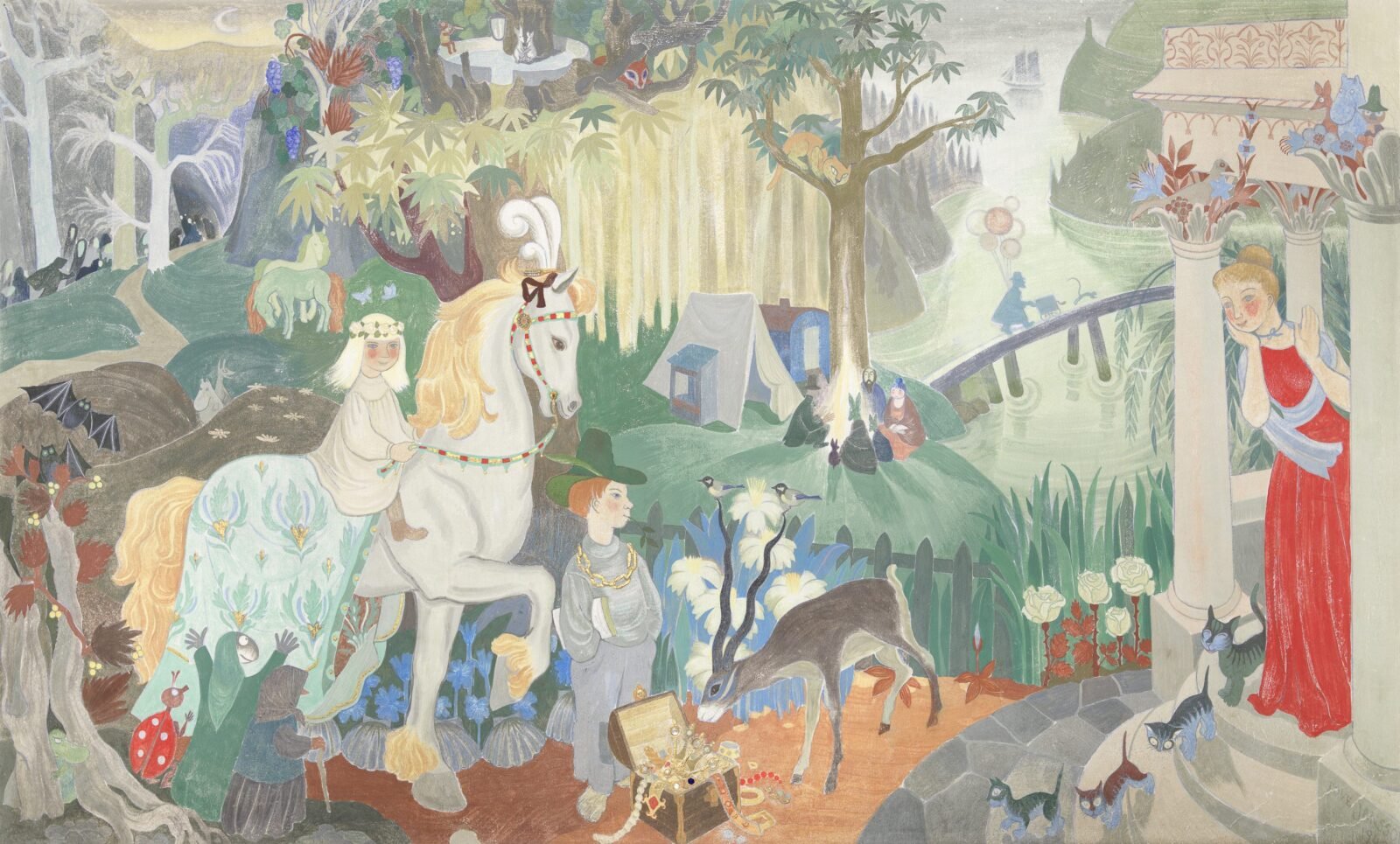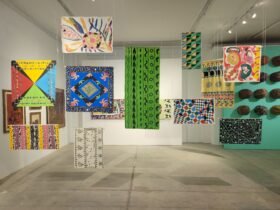HELSINKI — In Tove Jansson’s first Moomins novel, The Moomins and the Flood (1945), the titular characters travel through a terrifying forest before a rainstorm causes an epic flood, covering the land in danger and darkness. When the water begins to recede, the Moomins discover that they have been swept into a beautiful fertile valley. They decide to stay. Published during the closing months of the Second World War, the book is easy to read as an allegory, with the Flood representing the inescapable horrors of war and the Moomin Valley as an Edenic refuge.
An outspoken pacificist, Jansson spent the war years and beyond protesting conflict and seeking escape from it. Tove Jansson: Paradise at the Helsinki Art Museum captures both aspects of Jansson’s life and work, with a focus on her public art commissions from the 1940s through the 1950s. Most of her paintings do not reflect the reality of the war, but two small, worn works on paper speak volumes. Both are cityscapes inspired by her travels through Germany in the late 1930s, where she witnessed the terrifying rise of Nazism. One shows a prominent swastika flag, the other shows a dark street surrounded by oppressive black buildings. A crowd of shadowy figures moves towards a small speck of orange light in an open doorway; Are they refugees fleeing for the glimmer of hope, or are they fascists rushing to eradicate it?
This is the world Jansson wanted to escape, especially now that his older brother is fighting at the front. As she wrote to a friend in 1944: ‘I have never dreamed and planned so much as in recent years. Not as a game, but as an absolute necessity.” As this exhibition shows, Jansson saw dreams and playfulness as essential relief from the hardships of war, which continued even after the armistice.

In bombed-out Helsinki and beyond, a government reconstruction program created opportunities for artists, and Jansson was able to earn a living for the first time with her Moomin comic and a series of public commissions. In both efforts, she used images of paradise, forests and fairy tales to create a unique imaginative world that appeals to adults and children alike.
Moomin characters make cameos in many of her murals, such as her frescoes ‘Party in the City’ and ‘Party in the Countryside’ (both 1947). In the first of these, Jansson depicts herself staring at the viewer, her back defiantly to her lover Vivica Bandler, with whom she had recently bitterly broken off. On the table next to her is a small Moomintroll, perhaps a mascot representing a gateway to a more fantastical world.
Moomin characters are more common in works explicitly designed for children’s spaces, such as her diptych ‘Fairytale Panorama’, created for a nursery school in 1949. The two paintings are delightful fantasies, packed with whimsical details of princesses, magical landscapes and fantastic creatures. But even here, as in all her paradisiacal paintings, there are subtle hints of menace: bats flutter, lightning bolts threaten a storm and cats prowl hungrily. This is not pure escapism, but an expression of a state in which joy and fear are allowed to coexist.

Many of these murals, including the ‘Fairytale Panorama’, were created for specific locations and are not present in the exhibition. However, the recent discovery of several rolls of preparatory charcoal drawings on a 1:1 scale in a corner of the artist’s studio makes some form of presentation possible here. They are not rough sketches, but fully developed scenes, worthy of being seen as works of art in themselves. With their monochrome shadow strokes, they have a coincidental kinship with Jansson’s earlier sketch of a Nazi-ravaged city, and certainly offer a more solemn perspective on the final vividly colorful frescoes, which can be seen in projections alongside the drawings.
A handful of Jansson’s paradise paintings read uneasily through a contemporary postcolonial lens, such as a piece made for a rubber company with idealized workers on a plantation. Another pair of paintings, probably made in 1939 and 1940, are Gaugin-esque in their delineation of an imaginary sunny Polynesian island populated by happily unclothed people. Jansson created a number of works in this style in the belief that they would sell her and provide her with much-needed cash during the brutal Winter War of 1939-40, in which the Soviet Union invaded Finland. She was wrong; it turned out to be the Moomin comics and public commissions that gave her both the creative and financial lifeline she needed.
Jansson’s interdisciplinary oeuvre demonstrates a radical commitment to the profound necessity of play, dreams and escapism. She took children seriously, which is reflected in the thoughtful, unobtrusive design of the exhibition. Paintings hang low to the ground, Moomin creatures hide among the architecture and there are doors you can open and kaleidoscopes you can look through. The exhibition – imbued with the same knowing nostalgia as her works – is both comforting and subtly subversive.







Tove Jansson: Paradise continues at the Helsinki Art Museum (Eteläinen Rautatiekatu 8, Helsinki, Finland) until April 6, 2025. The exhibition was organized by Heli Harni.













Leave a Reply